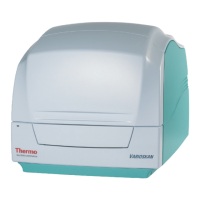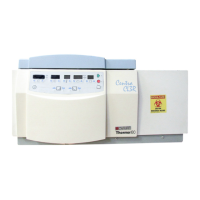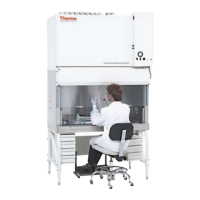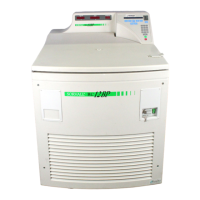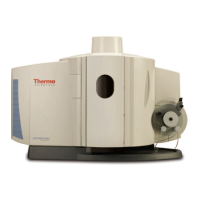1
Introduction
Overview of an LC/MS Analysis
Thermo Scientific Orbitrap Fusion Series Hardware Manual 3
Overview of an LC/MS Analysis
In a typical LC/MS analysis, the liquid chromatograph (LC) portion of the system separates a
mixture into its chemical components. The LC pump produces a solvent stream (the mobile
phase) that passes through an LC column (containing the stationary phase) under high
pressure. An autosampler introduces a measured quantity of sample into this solvent stream.
As the solvent stream passes through the LC column, the sample separates into its chemical
components. The rate at which the components of the sample elute from the column depends
on their relative affinities to the mobile phase and the solid particles that make up the column
packing.
As the separated chemical components exit the LC column, they pass through a sample
transfer line and enter the mass spectrometer for ionization and analysis. As the mass
spectrometer analyzes the ionized components and determines each mass-to-charge ratio
(m/z) and relative intensity, it sends a data stream to the data system computer. In addition to
supplying information about the mass-to-charge ratios of ionized compounds, the mass
spectrometer can also supply structural and quantitative information by performing MS
n
experiments.
When the system setup includes a syringe pump and divert/inject valve, there are four
additional ways to introduce a sample into the mass spectrometer, as described in Tab le 2.
The Orbitrap Fusion Series MS consists of an API source, ion optics, three mass analyzers,
and an ion detection system. The ion optics, mass analyzers, ion detection system, and part of
the API source are enclosed in a vacuum manifold.
Table 2. Methods of sample introduction into the mass spectrometer
Method Description
Direct infusion Connect the syringe pump directly to the atmospheric
pressure ionization (API) source of the mass spectrometer.
High-flow infusion Use a union Tee to combine the flow from the syringe pump
with the flow from an LC pump.
Automated loop injection Connect a sample loop, an LC pump, and the syringe pump
to the divert/inject valve. After you connect the plumbing,
specify the flow rate at which the syringe pump fills the
sample loop. After the loop is filled, the data system triggers
an injection.
Manual loop injection Connect a sample loop, a needle port fitting, and an LC
pump to the divert/inject valve. After you fill the sample loop
with sample, switch the position of the divert/inject valve,
which places the contents of the sample loop in the path of
the solvent flow produced by the LC pump.

